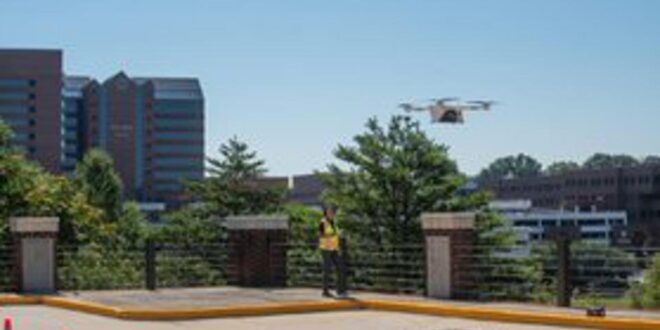Launch Pad for Drones at Wake Forest Baptist
Wake Forest Baptist Health has begun drone deliveries of medicines and blood. As soon as a patient checks in at a Wake Forest Baptist Health infusion clinic, their specific medicine is created at the hospital and flown over via drone, creating an on-demand pharmacy for medicine with a short shelf life. Wake Forest Baptist has introduced a couple of routes from their largest facility in Winston Salem to larger clinics located only a couple hundred yards away, but which are located on the other side of an interstate. These deliveries used to be made by couriers.
Wake Forest Baptist consists of five hospitals with more than 1,500 beds, 14 urgent care centers, 10 pharmacies, and 50 primary care offices. In addition to providing clinical care, this nonprofit does research and trains doctors. As a US pioneer of drone deliveries, innovation is clearly not limited to just the academic research teams.
The medical chain’s partner in this endeavor is United Parcel Service (UPS
The US Federal Aviation Administration (FAA) has rigorous safety standards surrounding drone deliveries. UPS Flight Forward is the first company to receive the full FAA’s Part 135 Standard certification. This is the highest level of certification for a drone operator. The North Carolina Department of Transportation (NCDOT) partnered with UPS Flight Forward in this endeavor. WakeMed in Raleigh North Carolina was UPS’s first regular delivery operation on a healthcare campus.
Rick Rys, a senior consultant at ARC Advisory Group, said that it is not surprising that the first approval under Part 135 came in the health care industry. “The FAA assesses the risks of causing harm to others and balances that against the lifesaving mission – the risk of causing harm to medical patients if the payload is not delivered.”
Bala Ganesh, a vice president at UPS’s Advanced Technology Group said Flight Forward is focused on health care deliveries. To make drone deliveries commercially viable, both “criticality” and an industry’s “willingness to pay” are important. “We never looked at delivering pizza.”
Current regulations always require drone flights to be within the line of sight of the drone’s operators. Mr. Ganesh explained some of the procedures relating to getting the approval and the actual flights. The FAA had to agree to the routes, agree that this was a safe area to fly in, and approve the safety procedures. The drone is preprogramed using GPS and has a geofence – GPS defined boundaries – that the drone can’t go out of.
Dedicated personnel are required at the takeoff and landing sites. These areas are cordoned off. Obviously, the package can only be attached when the propellers are off. Then the flight operator goes through a safety check list, ensures the drone is working properly, and makes contact with the operator at the destination site. The communication channel has redundancy built in – there are two lines open so that if one goes down communication still occurs. Once both the origin and destination sites signal that they are ready, the flight takes off. Finally, when the rotors are turned off, the container can be detached.
Under the current regulations, this is a costly form of parcel transportation. But Conrad Emmerich, the Chief Supply Officer at Wake Forest Baptist Health, said that the goal was to gain familiarity with drones and UPS as a partner.
Once the FAA approves routes beyond the line of site, the economics of drone deliveries will improve. “The future is routes beyond the line of sight, moving heavier payloads, over longer distances.” But in delivering life saving medicines, costs can be higher if patient outcomes are improved. “We have to be forward thinking; we want to elevate health care. We want to provide better access to care for those with poor access.” Adherence to medical regimes, and thus medical outcomes, are improved with better access.
“We are still in the early phase,” Mr. Emmerich explained, “compounded pharmaceuticals, personal protection equipment, and lab results will be next. We have been live for five weeks. We run every day during business hours.”
While the health care industry can justify higher delivery costs, the economics do need to improve according to Mr. Ganesh of UPS. Future drone control networks need to become more automated, particularly the way individual flights get approved. Over time, the FAA needs to approve flights that go beyond line of sight but rather are monitored remotely. The industry also needs to allow one operator to monitor multiple flights. “Without this,” Mr. Ganesh said, “this will not be economically viable.”
How long will it take for the FAA to approve flights that go beyond the line of sight as well as other measures to improve the economics of drone flights? Mr. Rys of ARC commented “don’t hold your breath, the FAA has been very slow to grant 135 exemptions.”
 Unmanned Aerial Vehicle The latest drone news
Unmanned Aerial Vehicle The latest drone news




